Muizz street features and Facts
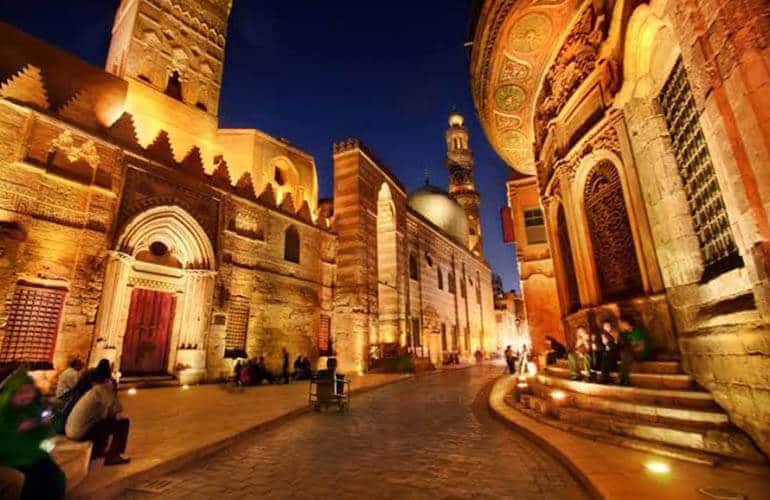
Al-Muizz li-Din Allah was the Fatimid caliph who conquered Cairo in AD 969. Al-Muizz Street was the former main thoroughfare of medieval times, entering the city through the southern gate of Bab Zuweila and exiting out of Bab al-Futuh to the north.
Over the centuries, buildings have encroached on its width and it is no longer very grand, but it is still vital and busy.
Lined with stalls, at Khan al-Khalili it is home to the coppersmiths’ market and an assortment of workshops.
Further along are shops selling a miscellany of coffee-house equipment such as tin-topped tables and sheeshas, before finishing with the garlic and onion stalls near Bab al-Futuh.
* The most famous Muizz street monuments you should visit:
1-Bab Al Futuh
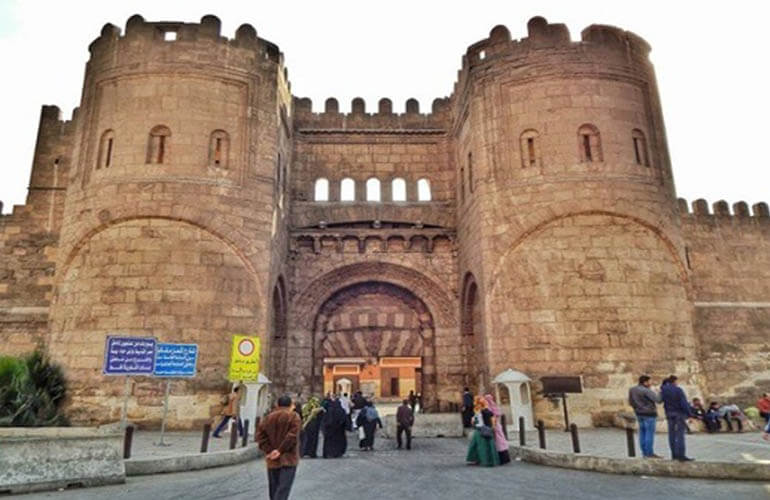
Bab al-Futuh or Gate of Conquest is one of the three surviving gates in the old city wall of Cairo. It was finished in 1087, so its antiquity and historical value are considerable, as well as worthy of appreciation as a visitor.
Bab al-Futuh was actually the part of the fortification built by the Vizier Badr al-Jamali. And an example in all its splendor of military architecture. You can also see that the door is decorated with geometric and vegetal motifs.
Its rounded towers stand out, offering a better and more solid defense than those of the square towers of Bab al-Nasr (the eastern gate). Similarly, its loopholes and grooves stand out so that flaming oil or boiling water could be poured on the attackers.
The defensive features of this gate were so important because they were built to defend the capital from the Fatimids. They did so twenty years after the Seljuks came to the Middle East and spread terror.
2- Al-Hakim Mosque
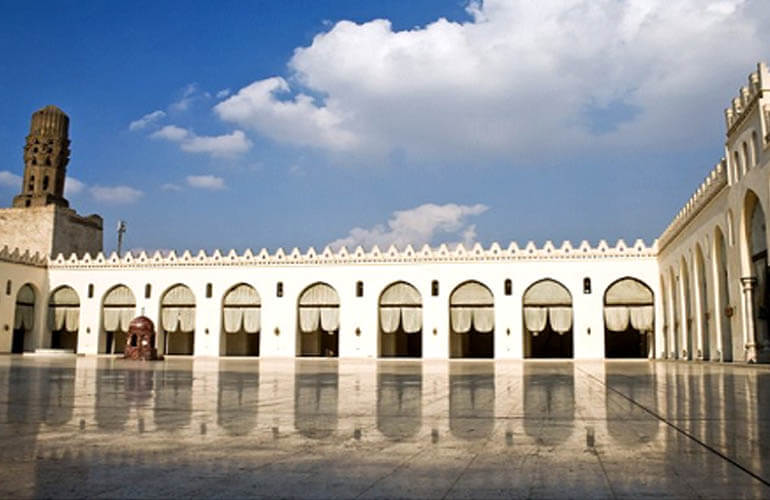
Al-Hakim mosque considered the second-largest Fatimid mosque in this region. We refer to Al-Hakim, a symbol of an expanding Islam, built between 990 and 1013 AD.
Al-Hakim mosque measures 120×113 meters is formed by thick pillars that support pointed arches and is located between two important gates in the wall, the so-called Bab al Nasr and Bab al Futuh. On both sides of the main entrance, there are corner towers, powerfully fortified, whose walls have collapsed and are crowned by minarets. The main material used to build this monument has been brick.
On the other hand, its ablutions fountain is small, it has been covered with red marble and at first sight, it seems to be located in the center of the majestic courtyard, but it is not.
Al-Hakim was a great persecutor of Jews and Christians who sought to impose his crude justice everywhere throughout his reign. His tomb whereabouts are uncertain, he disappeared one night and his body was never found.
Today, the Al-Hakim Mosque is the result of many restorations. For example, the white marble floor and interior walls are not typical of the original building. Modifications that have unfortunately taken away its historical value but are sometimes essential for its preservation.
3-Al Aqmar Mosque
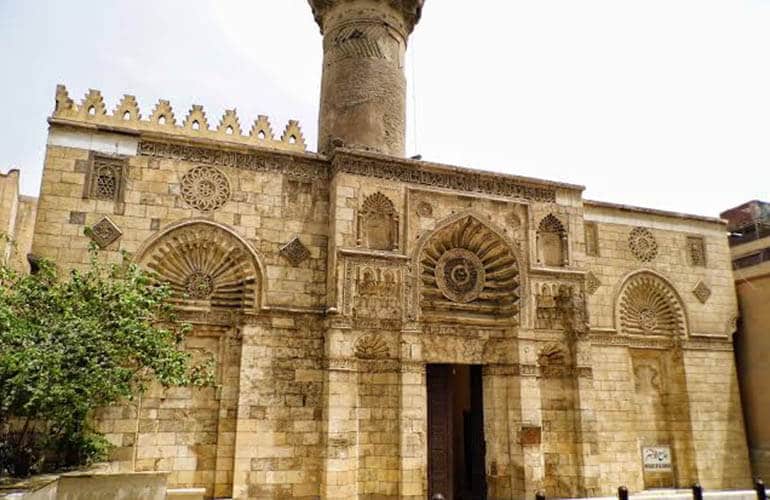
This is another architectural wonder is the Al Aqmar Mosque, also called the Grey Mosque, although its name means “moonlight”. Since its construction, it has been a rarity in Egypt: it was the first mosque with an ornate stone-faced
It was founded by Al-Ma’mun Al Bata’ihi during the reign of Al Mustansir. It is located north of the ancient Fatimid palace, on the main avenue of the Egyptian capital. Its facade and main entrance are aligned with that artery, a remarkable feature since it is the first one in which it was not oriented in the direction of Mecca.
The decoration of the mosque has a high symbolic load. One could spend a lot of time admiring the great number of signs that were inscribed in it, but here we will only deal with some of them.
The central medallion located in the middle of the tripartite facade is a remarkable example. There you can read the name of Mohammed Ali: “Mohammed” was written in a circle around “Ali”, located in the center.
Three other inscriptions honor the names of Al-Amir Bi Ahkam Allah and his minister Al-Ma’mun Al Bata’ihi. This shows the great importance that the figure of the Minister had acquired during the Fatimid era, as he was placed almost on a par with the current ruler.
A third of the inscriptions contain fragments of the Koran, the holy book of Islam. It is located on the lintel of the door. This façade has been magnificently preserved since its origins, something that cannot be said of the interior, which has unfortunately been modified enough to have changed substantially.
4-Bayn al-Qasrayn
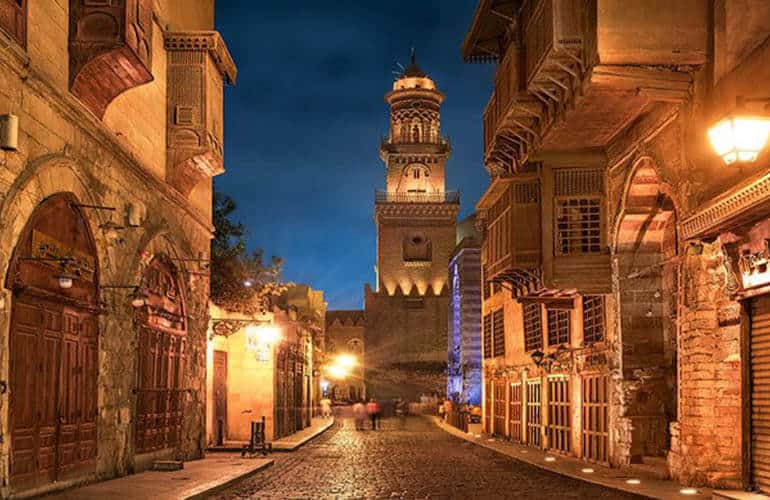
Bayn al-Qasryn was the main public square of the Egyptian capital in medieval times, built by the Fatimid dynasty, but today it is an important tourist center due to the presence of three imposing Mamluk palatial complexes: the Mausoleum and Madrasa of Qalaun, built-in 1279; the Mausoleum of an-Nasir Mohammed, dating from 1304, and the Madrasa and Khanqah of Sultan Barquq, from 1386.
Why visit Bayn Al-Qasryan:
The three buildings around it recreate an overwhelming atmosphere and shake with their beauty. The experts in architecture and history have cataloged this place as one of the most authentic, likewise, the Mausoleum and Madrasa of Qalaun, fixes its construction in the year 1279, which turns it into one of the oldest. Its decoration, based on stucco arches with stars, and its ceilings decorated with stained glass, give it a sublime beauty that you have to see for yourself.
The other two buildings also possess an indescribable beauty, so much so that the whole of Bayn al-Qasryan Square is a jewel in itself.
5-Bayt Al-Suhaymi
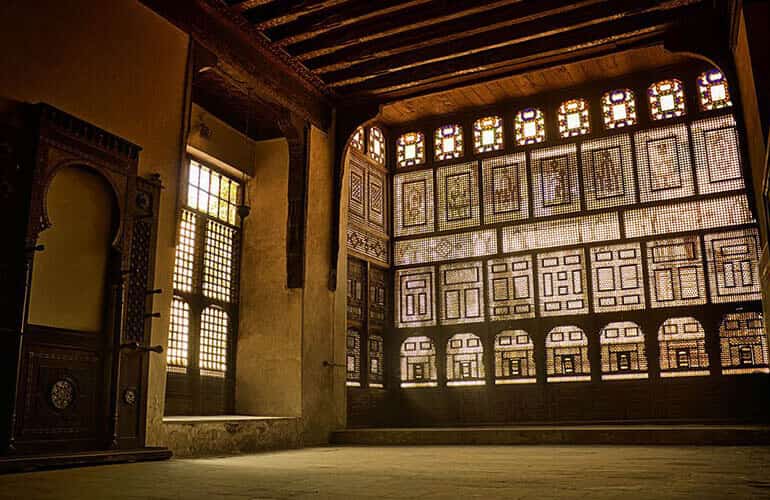
Of the many wonders that can be discovered in the city of Cairo, one of them is undoubtedly to know the daily life of its inhabitants, both in the present and in the past. Bayt Al-Suhaymi offers us a unique possibility to approach the old customs and ways of life.
Al-Suhaymi’s house is a 17th-century building belonging to a wealthy Egyptian citizen. Therefore, it is a kind of museum in our days, as it allows us to observe the techniques used by the wealthiest to make their homes pleasant stays despite the harsh climate outside.
In fact, the house as a whole was built with the outside in mind, with its changing temperatures and its arid condition. During the day, when the sun beats down but the wind is calm, the inhabitants of the place take refuge on balconies, terraces, and patios, under the shade of wooden grids.
When night fell, the low temperatures forced them to stay inside, where the high ceilings allowed the hot air to rise and did not bother the owners of the house, who moved further down.
The marble floors (cool, of course) and thick walls make this house a true paradise, something visitors will discover immediately upon entering it from the hot Egyptian capital. In the courtyards, marble fountains preserve the cold of the water by cascading from each bowl to the next.
In 1796, the house passed into the hands of Sheikh Ahmed as-Suhaymi, from whom it inherited its present name. It was he who extended the property, uniting it with several of the nearby residences. He also added the traditional Mashrabiyya panels, a classic of Cairo homes.
6- Mosque of sultan Al Muayyad
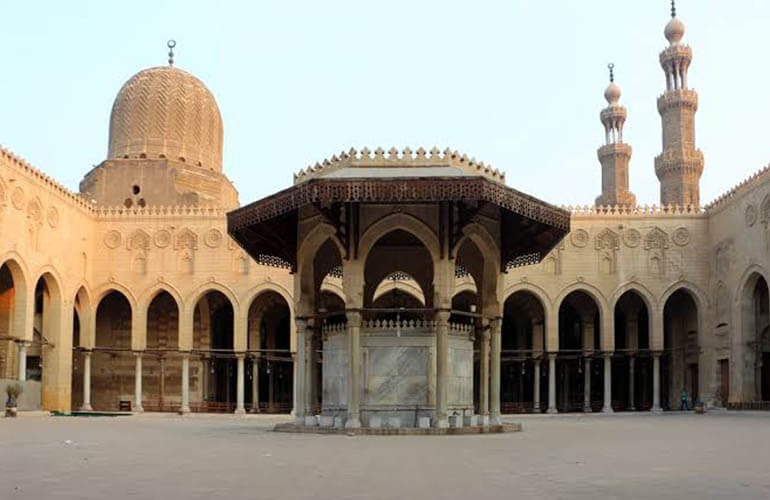
Located in the heart of Cairo since 1415, the Al-Muayyad Mosque is named after the sultan who ordered its construction. It was built next to Bab Zuwaila, one of the ancient fortified gates of the city (the other two are Bab el-Futuh and Bab al-Nasr, the famous Gate of Victory).
Today, its two very high minarets are a reference in Cairo and also constitute a not-to-be-missed tourist attraction. From up there, you can get the most fabulous views of the city, a truly recommendable spectacle.
The history of this mosque is extremely curious. It turns out that before it was built, the place where it was erected was occupied by a prison. None other than Sultan al-Muayyad himself was a prisoner there, and upon his release, he ordered its destruction.
And not only did he decide that a mosque should be founded in that space, but the building also houses a madrasa (school of the Islamic religion) and one of the largest bookstores in the city during his time, especially thanks to the sultan’s efforts to obtain donations and purchase materials.
During the 15th century, the madrasa was one of the most outstanding educational institutions in all of Islamic Egypt, with the eminent students of the time serving as its teachers.
The Mamluk style facade of the mosque dominates the view from all around it and generates a strong impact when it is discovered today hidden among the Cairo buildings. It should be noted that, at the time of its construction, it was not surrounded by so many buildings, but it was possible to distinguish it completely from a distance.
Book your Travel Package now to know more about Egypt history.






